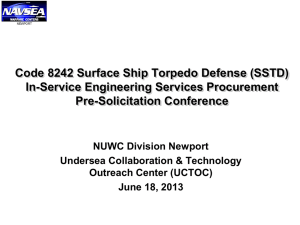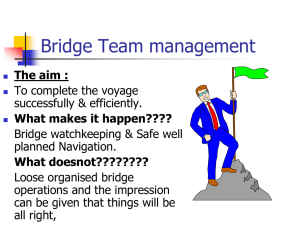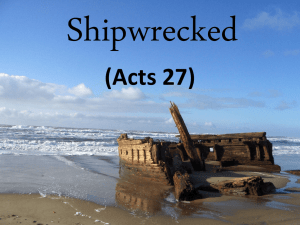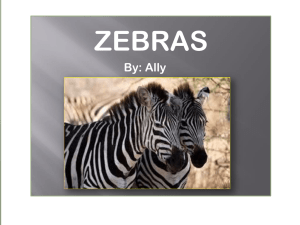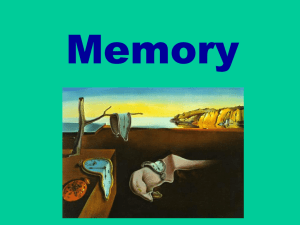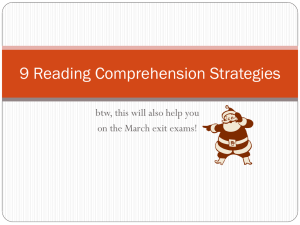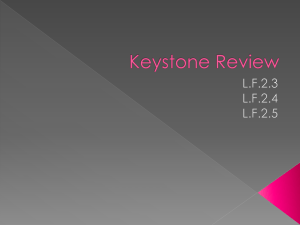Text Structure - Coshocton City Schools
advertisement
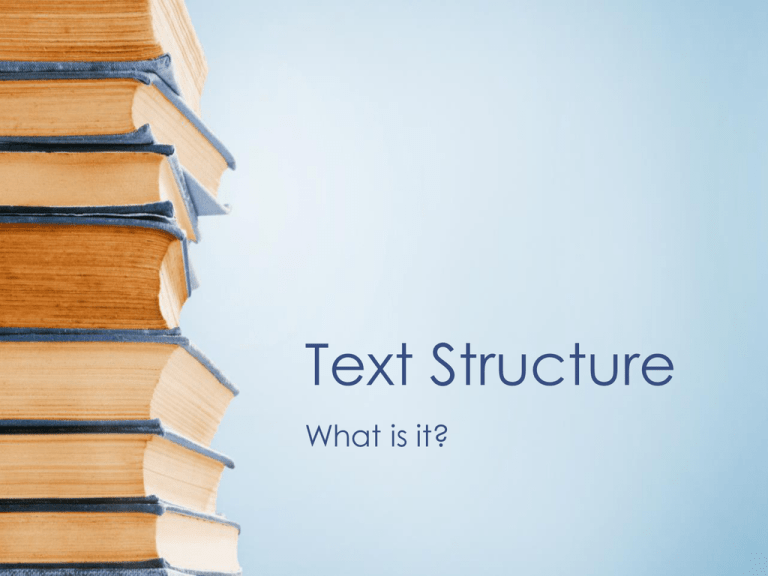
Text Structure What is it? Types of Text Structure • Chronological Order • Cause and Effect • Compare and Contrast • Problem and Solution • Description Chronological Order • The Greek root “chron” means “time” • So something that is written in chronological order lists events in the order they happen. • A story of someone’s life in chronological order will begin with his birth and end with his death. The events in the middle will progress in order. • You might see key words like First, Next, Last • Also known as: Sequence, steps, lists • Biographies, timelines, recipes, directions Chronology Alexander the Great Alexander the Great was an ancient Greek king of Macedonia. Born in 356 BC, Alexander became one of the most successful military leaders of all time. As a young boy, he was curious, fearless, and strong. His formal education began with Aristotle at the age of thirteen. From his teacher, Alexander learned about the Greek ways of living and thinking. As a prince, he also received plenty of training in sports and crafts of war. Alexander's tutorship under Aristotle came to an end when he turned sixteen. The same year, his father, King Philip, left to wage war against Byzantium. Alexander was now responsible for his kingdom. Alexander was an ambassador to Athens at the age of eighteen and the king of Macedonia at the age of twenty. As a king, he fought neighboring countries, stopped rebellion in his own kingdom, and went on a famous conquest. One of the first countries Alexander conquered was Persia. Then he went to Egypt and founded the city of Alexandria. His empire stretched from the Ionian Sea to northern India. Although Alexander had planned to combine Asia and Europe, he would not succeed after becoming ill with malaria in Babylon. His life ended in 323 BC, but his fame continues today. Exit Slip – Answer: 1. What is the topic of this passage? 2. What was the author’s purpose for writing it? 3. How does the author present the information? 4. Why is this text structure a good fit for this author’s purpose? Review – Chronological Order • What does “chron” mean? • What does chronological order mean? • What kinds of texts might be written in chronological order? • Why would an author choose chronological order? Cause and Effect • A cause is something that makes something else happen. Out of two events, it is the one that happens first. • To find the cause, ask, “Why did it happen?” • An effect is what happens as a result of the cause. Of two events, it’s the one that happens second or last. • To find the effect, ask, “What happened?” • Clue words: because, so, consequently, therefore, due to the fact, since, as a result, the reason for, thus, nevertheless. Give a possible effect for these causes: 1. Your alarm clock does not go off. 2. You drop your homework in the mud. 3. The electricity goes out on the night you were planning on doing your report. 4. A huge storm covers the streets with ice. 5. You mix up the sugar and salt in your recipe. Extended Practice – The S.S. James B. Stephens The SS James B. Stephens was an American liberty ship in World War II. In 1943, the ship was traveling in Suez when it was torpedoed by the German submarine U-160 about 150 miles northeast of Durban. One torpedo struck, igniting the fuel oil in storage, and the ship began to sink by the front end. A second torpedo struck and broke the ship in two. Both sections remained afloat, but the ship was on fire. The crew began to abandon ship. The explosion of the second torpedo overturned the motor lifeboat. The other lifeboats were able to pick up all of the men in the water except for one man who was not wearing a life jacket and could not swim. He drowned before he could be rescued. An Allied warship sank the back section of the James B. Stephens with gunfire. A British warship attempted to take the front section in tow to Durban, but it sank while under tow in heavy seas. Of a total crew of 63, 62 were rescued. A crewman, Edward F. Racine, was awarded the Distinguished Service Medal for righting the overturned motor lifeboat. 1. What was the topic of this passage? 2. What was the author’s purpose for writing it? 3. How were the events in the passage related? 4. What was the text structure used in the passage? 5. List two effects of the cause: The S.S. James B. Stephens was torpedoed by a German U-Boat (things that happened because the ship was hit with a torpedo). The S.S. James B. Stephens was an American liberty ship in World War II. In 1943, the ship was traveling in Suez when it was torpedoed by the German submarine U-160 about 150 miles northeast of Durban. One torpedo struck, igniting the fuel oil in storage, and the ship began to sink by the front end. A second torpedo struck and broke the ship in two. Both sections remained afloat, but the ship was on fire. The crew began to abandon ship. The explosion of the second torpedo overturned the motor lifeboat. The other lifeboats were able to pick up all of the men in the water except for one man who was not wearing a life jacket and could not swim. He drowned before he could be rescued. An Allied warship sank the back section of the James B. Stephens with gunfire. A British warship attempted to take the front section in tow to Durban, but it sank while under tow in heavy seas. Of a total crew of 63, 62 were rescued. A crewman, Edward F. Racine, was awarded the Distinguished Service Medal for righting the overturned motor lifeboat. Review Cause and Effect • What is a cause? • What is an effect? • Why might an author choose to write a passage as cause and effect? Compare and Contrast • Comparison and contrast are ways of looking at objects and thinking about how they are similar and different. • Compare cue words: similar, both, also, too, as well, is like. • Contrast cue words: different, on the other hand, however, but, although, unlike, while. Why use Compare and Contrast? • There are two main reasons that people use comparison and contrast: • To Explain--You might compare and contrast kinds of food, for instance, to help someone understand which food need to be refrigerated and which can be stored in a cabinet or in a bowl on the counter. • To Evaluate--You might compare and contrast kinds of food to show why one kind of food or brand of food is better than another. For example, apples are a better snack than butter. Most people have wondered about the differences between horses and zebras. To understand the difference, you must first understand exactly what a horse is. The horse is a hoofed, plant-eating mammal of the family Equidae. This family includes domestic horses, wild horses, and zebras. All are swift, plains-dwelling herd animals who eat coarse grass. Horses, as we know them, evolved in North America and spread over the world. They were hunted by early humans and put to work by Asian nomads. Until the mid20th century, horses were widely used for warfare, agriculture, and transportation. Today, most horses are used for farming purposes. Few modern horses roam wild. On the other hand, most zebras live in open plains or brush country. Mountain zebras like rocky hillsides. Zebra herds on the Serengeti of East Africa can be as large as 200,000 zebras. All travel in family groups led by a stallion. The plains zebras usually mix with other grazing animals, such as wildebeest and antelopes. You would have to look at the DNA of horses and zebras to understand their physical differences. Zebras and horses have very similar bodies except for their skins! 1. What is the topic of this passage? 2. What cue words are used? 3. What is the text structure? 4. Make a venn diagram using details from this passage. Review Compare and Contrast • How can you tell if a passage is written using compare and contrast? • Give an example of some cue words for compare and contrast. • What are two reasons authors write a compare and contrast essay? Description • This type of text structure features a detailed description of something. • The purpose is to give the reader a mental picture of the topic. • A topic, idea, person, place, or thing is described by listing its features, characteristics, or examples. • Cue words: For example, for instance, specifically, in particular, in addition. • *Look for the topic word (or synonym) to be repeated throughout. • The topic can be described using the 5 senses. Gregory by Barbara Carter Gregory is my beautiful gray Persian cat. He walks with pride and grace, performing a dance of disdain as he slowly lifts and lowers each paw with the delicacy of a ballet dancer. His pride, however, does not extend to his appearance, for he spends most of his time indoors watching television and growing fat. He enjoys TV commercials, especially those for Meow Mix and 9 Lives. His familiarity with cat food commercials has led him to reject generic brands of cat food in favor of only the most expensive brands. Gregory is as finicky about visitors as he is about what he eats, befriending some and repelling others. He may snuggle up against your ankle, begging to be petted, or he may imitate a skunk and stain your favorite trousers. Gregory does not do this to establish his territory, as many cat experts think, but to humiliate me because he is jealous of my friends. After my guests have fled, I look at the old fleabag snoozing and smiling to himself in front of the television set, and I have to forgive him for his obnoxious, but endearing, habits. 1. What was the topic of this paragraph? 2. What is the text structure? 3. Write down 5 details or adjectives found in the paragraph. 4. Why does an author choose to write descriptively? 5. Write a short (3-5 sentences) description of your favorite food. Review Description • What two reasons might an author choose to write a description? • What cue words might you find in a descriptive paragraph? • What word or words might be repeated throughout? Problem and Solution • Problem and Solution is a pattern of organization where the author states a problem and then lists some ways to fix it. • Cue words which may indicate that information in a passage is ordered in the problem and solution pattern of organization: proposes, suggests, solution, answer, remedy, prevention, and fix. • Most fictional stories will contain a problem and a solution. • Sometimes, a persuasive text can be organized as problem – solution. When you think about going on a cross-country road trip, or going to the movies, or even just taking a quick trip to the grocery store, most people think of the same way to travel to each of these places: in a car. But, lately, lots of people have been concerned about problems with how cars are designed and fuelled today. Many cars run on gasoline, which is expensive and pollutes the air, and if something is hurting the environment and your wallet, something isn’t right! So how can we keep our cars running and use something that’s safer for the environment and more affordable? Scientists have been working to find the answers. Bioethanol is a fuel that’s made from plants like corn or sugar cane. This type of fuel is better for the environment and is cheaper than gasoline since corn is so readily available. Another possible fuel alternative is electric cars. Imagine driving a real car that runs like a remote-controlled car—that is, a car that runs completely on batteries that could be charged at the end of the day! Or what if we had flying cars, like in the movies? One day, flying cars may be possible with the use of strong magnets. In fact, some trains already use this magnet technology to create levitation, which is a technology where an electromagnetic reaction allows a train to ride on a cushion of air. But all of these fuel alternatives will require extensive research and hard work before they become widely available to the public. Until then, a great solution might simply be carpooling. If more people travel in the same car, the cost to each person is reduced, and there are fewer cars on the road polluting the air. 1. What is the topic of this passage? 2. What is the text structure? 3. What is the author’s purpose for writing it? 4. What is the problem? 5. What is one solution the author presents for this problem?


